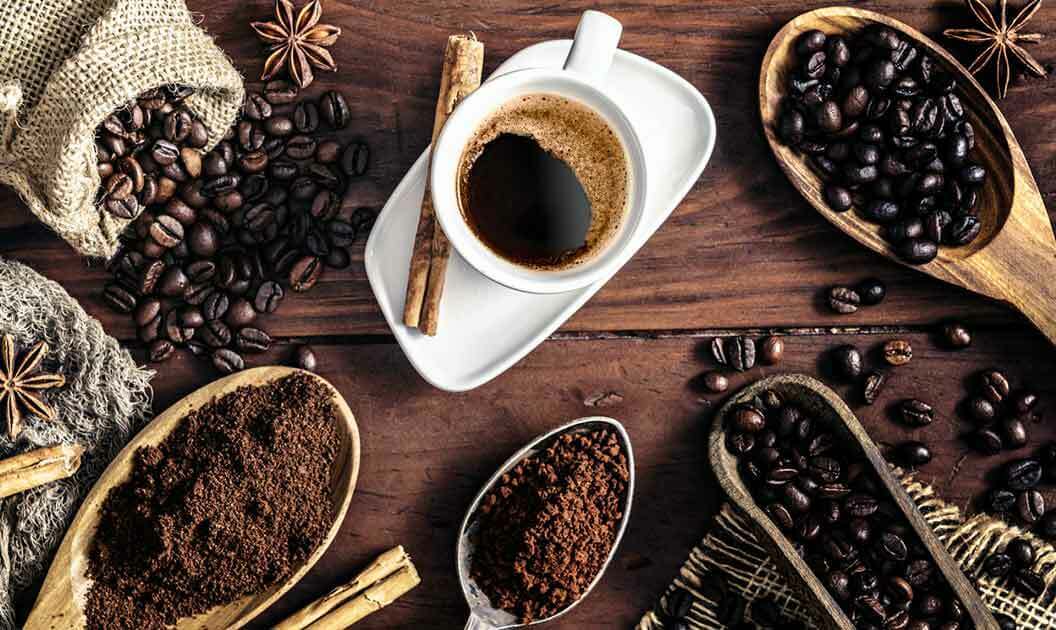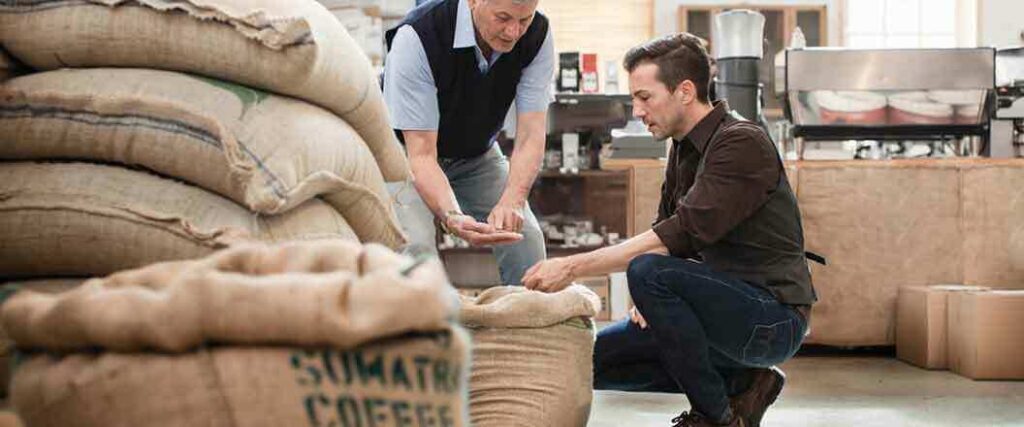
The U.S. Food and Drug Administration (FDA) and the U.S. Department of Agriculture (USDA) regulate imported coffee in the form of beans and as grounds. Customs and Border Protection (CBP) enforce their regulations. The various coffee import categories are determined by the Harmonized Tariff Schedule (HTS) code system.
The wide variety of coffee products available to import means that thorough research is needed. We’ll provide you with a simple step-by-step guide to the import process and then go into detail about the legal and ethical considerations of the international coffee market.

In 2021, the U.S. imported $7.24 billion worth of various coffees and related products. In fact, coffee is the second most consumed beverage in the U.S. (bottled water being the first).
Since coffee cultivation within the U.S. is extremely limited due to its climate needs, there is always a demand for more coffee importers.
To start importing coffee, we recommend starting with the following steps:
Each step in the process above has its unique challenges. This is why USA Customs Clearance recommends that new importers, or even experienced importers bringing in a product for the first time, work with a licensed customs broker.
In the following sections we’ll review the process in more depth and point out specific legal requirements, the main Partner Government Agencies (PGAs) involved in importing coffee products.
At this time, there is no special license or permit required to import coffee or related coffee products. There is a ban on importing fresh, unprocessed, whole coffee fruits with pulp because it’s an exotic fruit fly risk.
Considering that coffee cultivation within the continental U.S. is so limited, it’s also not a risk worth taking. For new importers looking for a product that sells well and has minimal import restrictions, it's harder to find a better product than coffee.
Although a specific import license for coffee is not required, there are a number of other documents to have on hand for the customs clearance process. We’ve mentioned some of these already.
These are standard import documents for most products. When it comes to coffee, however, there are also export concerns depending on where the beans are coming from.
Importers should become familiar with the International Coffee Organization (ICO) and specifically the Country of Origin Certificate. First, it should not be confused with a Certificate of Origin, which can be obtained from an exporting nation’s department of commerce or equivalent organization.
As of the latest membership ratification in 2022, the United States is not a member of the ICO. However, several countries that primarily export coffee to the U.S. are members. This includes Vietnam, Brazil, Honduras, and others. The CBP and the FDA recognize and accept the ICO’s version of a certificate of origin.
U.S. coffee importers can therefore choose to use the ICO version or a standard Certificate or Origin issued by the country of origin.
Most coffee and coffee product imports are duty-free. Under the Harmonized Tariff Schedule of the U.S. (HTSUS), that includes the following:
None of these products are subject to import tax nor are they impacted by quota tariffs from the U.S. Department of Agriculture. That means you can import as much or as little as you’d like without penalty.
If you are traveling internationally and wish to bring back personal supplies, the same rule applies. You can bring coffee into almost any U.S. port of entry.
Importers and travelers going through Hawaii or Puerto Rico cannot bring in green coffee beans. These islands have their own coffee productions and laws are in place to protect them. They can pass through, however, if a person is just stopping over on their way to another destination.
There are also some exemptions to the duty-free status of certain coffee imports. Any coffee preparation that contains blended syrups is subject to taxes and duties based on sugar content.
While you may not be paying duties, other fees, such as processing and maintenance costs, and harbor fees, will still apply.
To learn more about green coffee beans and how to import them, check out our article Importing Green Coffee Beans to the U.S.

CBP works with two other PGAs when coffee products enter the U.S. or any of its territories.
Depending on what type of coffee product you are looking to import, you may need to deal with one or both agencies.
As a consumer food product imported for immediate consumer retail, coffee falls under FDA regulations. Officially, coffee and coffee beans are a beverage and/or beverage material.
As an agricultural product, namely as a green bean, it’s regulated by the USDA.
All imports, FDA or USDA-regulated, will still need to follow CBP entry and document requirements.
Like other foods for human consumption, imported coffee is held to rigorous quality standards. To enforce those standards, importers should be aware of the following:
This is required to give the agency the ability to regularly inspect food facilities and ensure processing and packing procedures are safe and sanitary. It keeps importers in compliance with the Bioterrorism Act of 2002 and the Food Safety and Modernization (FSMA) Act of 2011.
All coffee products must have a label upon import that declares their country of origin. However, this label does not have to be used on individually sold units.
In addition to registering processing facilities (if needed), the FDA also requires food imports to file a Prior Notice report. The report will contain multiple details about the shipment, such as:
Importers have between 15 and 30 days to file a Prior Notice. The time frame is dependent on which available e-file system is used.
The FDA inspects samples of your coffee imports by looking for compromised beans. Bean quality, for both green and roasted products, is identified by grade. The FDA system grades beans on a scale between one and nine. The lower the number, the better quality the coffee will be. Note, coffee grades from the ICO differ from the testing grade standard used by the FDA.
Beans are tested in mixed sample batches of 500 beans at a time. The majority of the time, such testing is done at the facility where the beans originated, or where they were roasted. Proof of grading is then provided as part of the import documents.
For import purposes in the U.S., coffee beans graded as an eight or above are not permitted into the consumer market.
The USDA’s main concern is shipments of green coffee beans. The roasting process used on beans to give them distinct flavors eliminates the majority of possible pests, so finished products are rarely an issue.
If your shipment of green coffee beans arrives and is found to contain pests, a quarantine order may be issued.
Beans can be fumigated to get rid of any pests that might have traveled with the shipment. While it may save your product from a ‘destroy in port’ order, chances are high that you will need to pay the USDA for the fumigation services. This would likely include additional storage or harbor maintenance fees while the quarantine order is in place.In rare cases, importers may need to fill out an APHIS PPQ 587 form. This particular permit is normally required when importing plants and seeds for agricultural purposes.

Our Licensed Customs Brokers Will Personally Guide You.
Where you choose to source your products from will depend on your place within the coffee supply chain. Those planning on importing for direct to consumer sales will typically focus on imported beans that have already been roasted and/or ground.
If you plan on importing to U.S. based manufacturing centers, you’re likely looking at green coffee bean sources.
In both cases, importers should also consider the type of bean they wish to focus on. The two most mass-produced beans are:
There are, of course, other bean varieties that coffee connoisseurs can rave about, but those are better investigated independently. Regardless of the country, a supplier’s status as an FDA registered facility should be taken into account. If you have a particular grower or overseas company in mind that isn’t registered, the FDA has a clear registration process for them to follow. However, it is one more step we recommend you finalize before starting the actual import process.

These are countries that primarily grow coffee beans for export to production facilities that will apply their own roasting techniques.
| Country | Number of 60-Kilogram Bags Produced |
| Brazil | 66.3 million |
| Vietnam | 27.5 million |
| Colombia | 11.5 million |
| Indonesia | 9.7 million |
| Ethiopia | 8.35 million |
Each of the top countries we’ve listed can be counted on in terms of quality and consistent production. Their agricultural coffee industries are well established and finding qualified export services is relatively easy.
However, U.S. importers should also take a look at some lower producing, but rapidly rising stars of the coffee world.
Aside from being regionally close to the U.S., and thus being less expensive to transport, each of the nations listed has a standing Free Trade Agreement (FTA). Peru independently, while the others are part of the CAFTA-DR agreement.
FTAs do much more than cut costs. They provide a structured and supportive trade environment that makes it easier for new importers to gain a foothold with smaller, specialty growers.
The agreements also help smaller farms in those nations that grow coffee within cooperatives or as small shareholders. These allow for sustainable growing and Fair Trade practices to flourish.
Perhaps you’re looking for a more direct to consumer (D2C) product. These are preferred by a variety of importers, from small specialty shops to mass market wholesalers.
The D2C coffee market includes items such as:
In these cases, the top producing companies may not be best for large quantity imports. Countries that are prized for their green products often have limited domestic production facilities because the actual beans have greater market value.
If you are in the market for small-batch roasted coffee, refer back to the table for top coffee growers. You’re sure to find consumers that appreciate their unique characteristics. Just don’t expect to get it in large quantities.
| Exporting Nation | US Market Percentage | Product Value (USD) |
| Switzerland | 42.2% | $761 Million |
| Canada | 34.3% | $578 Million |
| Italy | 6.97% | $117 Million |
| Colombia | 4.82% | $81.2 Million |
While these countries are prized for their roasted products, their well established industries can be daunting for new importers. Today’s market is also marked by a change in certain consumer preferences outside of cost and flavor.
For example, studies have shown customers are willing to pay more for sustainably sourced coffee. When choosing to import finished products, it may be worth looking into where such companies buy their green coffee beans from and if that can then be used as a selling point.

Our Licensed Customs Brokers Will Personally Guide You.
Both global companies and small local shops have a responsibility to ensure that their business has a reputation that people can trust
Companies that are certified under the World Fair Trade movement are companies that are dedicated to empowering and stimulating the source community, protecting the environment, investing in the future, and providing sustainable incomes for all workers in the supply chain.
Over 100 million people in tropical regions are supported by the coffee industry. Fair Trade supports their native lifestyles and ensures that they continue to have decent paying jobs and healthy lives.
Information on the requirements to get Fair Trade certified as producers, distributors, companies, and retailers can be found on the Fairtrade International website.
Learn how to import coffee into the US in a smart and sustainable way. USA Customs Clearance can be your import business partner and help ensure your products arrive safely and pass inspections.
Our licensed customs brokers can assist you with purchasing Custom Bonds, Importer of Record Registration, and more.
Haven’t fully decided to commit yet? We offer 1-on-1 consulting sessions with our experts in the industry to help you gain a better understanding of the import process as a whole. In just 30 minutes you could be armed with new information to guide your coffee import plans into the future.
Call us today at (855) 912-0406 or complete an online contact form. Our experts will have you sipping the perfect cup of java in no time at all.
 Copy URL to Clipboard
Copy URL to Clipboard
Hi My name is Jose and I’m interested in bringing coffee from my uncle’s plantation in the Dominican Republic. Want to know how the process works for the DR.
my name is mike I live in United States I need to import coffee from Ethiopia what should I do to start the process ?
I plan to import to the United States. I have a partner who is growing coffee in Guatemala, and we want to bring those products to US anybody can help us?
Hi Interested In importing Kenyan Coffee. Are you able to assist with that?
Help!
I live in Oregon and starting my coffee importing business.
Can you help?
Thank you.
If I take physical delivery of an expiring "C" contract, 37,500 lbs at Dupuy warehouse, Houston, do I need an importors license? (seems the coffee would already be US Customs cleared by the contract counter party) as it is physicially in Dupuy's warehouse.
Hello,
My name is Luis Guillin. I wish to have information on how to import coffee products from Colombia to the United States. I don't know if you could help me or tell me who I can talk to. I am totally new and I need guidance on the process or requirements needed it.
Thank you.
Hello,
I'm growing coffee in Colombia, I would like to import it to
U.S. How I can start the process?
Thanks.
Hi Juan,
There are many steps to go through when it comes to importing food into the U.S. Our best suggestion is to schedule a consulting session with our Licensed Customs Brokers. They'll give you a complete summary of what will be required to legally import your coffee into the U.S.
You can sign up for a consulting session at the link below:
Import Consulting Services
Hello,
Need help to take coffee into the usa.
I want to know how much is the shipping price from my country.
What size of the box do i have to use to put my coffee.
I'm going to send ground coffee in one pound AND half pound bags.
Thanks
Hi Felipe,
One of our customs experts will reach out to you shortly to assist you with your inquiry. We look forward to helping you!
I am growing coffee in the southern part of Mexico and have a plan to import to the united states. But have a partner who is growing coffee in Guatemala and we want to bring those products to US anybody can help us?
Hi Lucas,
We can absolutely help you with this! We work with many importers that bring coffee into the U.S. One of our customs experts will be reaching out to shortly via e-mail. We look forward to helping you!
Hello, I’m looking to import coffee to the US but don’t know where to start
Hi Gabriel,
We can definitely help you with this. The best place to start is to speak with one of our Licensed Customs Brokers. They'll advise you on all of the import regulations, duties that you'll be expected to pay, and more. We look forward to helping you!
For some time i've had the idea of import coffee, but seems nobody knows about the proccess of it, paperwork, what i need to do do you know anybody??? live in New Jersey. can you help me with it???
Hi Javier,
We can absolutely help you with this! We have experience importing coffee of all different types (ground, beans, organic, etc.) and can assist you with importing it. We've responded privately with the information you requested. We look forward to working with you!
Hello my name is Jonathan Heiland, I am one of the Customs Specialists with USA Customs Clearance. We will gladly assist you with your import but we will need more information about your shipment. For immediate attention please reach out to consulting@afcinternationalllc.com. We look forward to working with you!
Hello my name is Jonathan Heiland, I am one of the Customs Specialists with USA Customs Clearance. We will gladly assist you with your import but we will need more information about your shipment. For immediate attention please reach out to consulting@afcinternationalllc.com. We look forward to working with you!
I have another question: Do I need open an importer/exporter to bring coffee from Brazil?
Hi
I am looking at importing coffee from Brazil, but I still have many question about fees, taxes, obligations, shipping....if you guys can share more informations I really appreciate that.
Hi, I’m looking at importing organic coffee to United States. I have identified the growers but do not know the roasting process.
Would like to get information on import to USA
Good Morning Jeewa! That is such a great question! We would be more than happy to answer that question and any others you might have! I have attached a link to our customs consulting session! We look forward to hearing from you!
We have coffee in caMero on and wait to bring to texas.